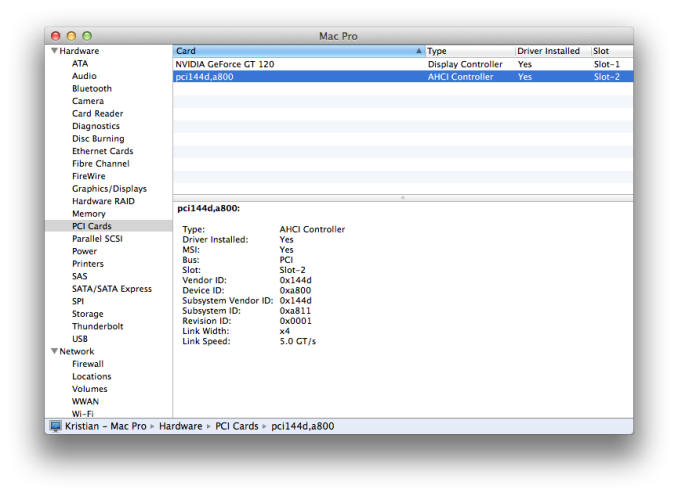Samsung SSD XP941 Review: The PCIe Era Is Here
by Kristian Vättö on May 15, 2014 12:00 PM ESTBoot Support: Mac? Yes. PC? Mostly No.
Booting from PCIe devices has always been rather quirksome because the BIOSes in motherboards are designed to boot from SATA devices, as they usually do. Most PCIe SSDs and SATA adapters include boot support by loading special drivers before the BIOS, which makes the drive visible in the boot screen. Without the drivers the drive won't show up in the BIOS but once you boot into the OS it will be accessible like any other drive. The problem is, you can't boot from the drive unless it shows up in the BIOS' boot screen.
Unfortunately, the XP941 doesn't seem to include the drivers necessary to enable booting. At least no driver loading screen shows up during boot, which suggests that the XP941 doesn't even have such drivers (ASUS is also telling us that this is the case). I'm thinking that the XP941 is designed for UEFI booting because from what I have heard, you don't need the drivers for UEFI boot but there is still some sort of a UEFI key needed to make the drive bootable. I did try the UEFI boot method on my ASUS Z87 Deluxe board but even though I was able to install the OS to the drive just fine, it wouldn't show up in the boot order.
The good news is that 9-series chipsets bring some ease to the situation. Back when the 8-series was introduced, there weren't many PCIe SSDs on the market but this year we will see PCIe entering the mainstream segment. That obviously forces the motherboard manufacturers to work on PCIe boot support and we can confirm that at least AsRock's Z97 Extreme6, which has a PCIe 2.0 x4 M.2 slot, supports booting from the XP941 out of the box. Whether other 9-series motherboards support booting from the XP941 remains to be seen. Most manufacturers, however, seem to be limiting the M.2 slot to just two PCIe 2.0 lanes, so you wouldn't want to use the XP941 in those boards anyway (unless the XP941 is used in a standard PCIe slot with an adapter). Anyway, we'll be sure to investigate the bootability of the XP941 in our motherboard reviews and work with the OEMs in order to bring better support for PCIe booting.
Update 5/20: ASUS just sent me an email that all their Z97 based motherboards will get a BIOS update that enables booting from the XP941. The BIOS is currently in beta testing and ASUS is expecting public release in about two weeks.
Macs, on the other hand, can boot from the XP941 just fine. I confirmed this using an early 2009 Mac Pro and the volume in the drive shows up in the boot option screen just like any other volume does. I have to admit that I don't know why exactly this is the case, but I'm guessing it's a fundamental difference between how the EFI in Macs and the BIOS/UEFI in PCs handle device recognition.
Under OS X, the XP941 shows up like any other SATA device. Since it utilizes the AHCI command set, OS X thinks it's a SATA device even though it's not. However, it's also listed under PCI cards but the page doesn't provide any meaningful info.












110 Comments
View All Comments
UltraWide - Friday, May 16, 2014 - link
The random read/write scores are too low for this SSD to make a difference in real world use. I think it's better to wait for the 2nd generation of M.2 to see some more mature controllers with improved IOPS or random read/write speeds.DaveGirard - Friday, May 16, 2014 - link
It would be nice if you could test one of these in an external Thunderbolt 1/2 PCI chassis.RamCity - Friday, May 16, 2014 - link
That sure is a good idea, and Rob over at barefeats.com tested the XP941 (installed in a standard PCIe adapter) in a thunderbolt chassis but maxed out one thunderbolt port at 1375MB/s, no matter how many XP941's are installed. To get higher throughput the chassis now need individual thunderbolt ports per SSD installed.His review is about halfway down here: http://barefeats.com/hard183.html
Rod (vendor rep for RamCity.com.au)
Peeping Tom - Friday, May 16, 2014 - link
The picture of the M.2 above gave me an idea. It would be interesting if storage capacity could be expanded like RAM using multiple M.2, i.e. plug and play. You insert a new stick and the system automatically expands the current partition to include the new drive (rather than creating new, separate partition). No more SATA/power cables, and it would make the system more uniform with the existing RAM/slot architecture. Would take many lanes thoughpoordirtfarmer2 - Saturday, May 17, 2014 - link
Or how about the card being lots longer - a daughter card of sorts - and allow for slapping additional SSD modules to it as the user needs (or can afford).Laststop311 - Sunday, May 18, 2014 - link
Waiting for pci-e 3.0 x4 m2 connectors before buying the rushed tech on and older backbone.Marucins - Monday, May 19, 2014 - link
ASRock Z97 Extreme6 - PCIe 2.0 x4http://nimg.cdrinfo.pl/2014/05/Samsung-XP941-M.2-S...
Marucins - Monday, May 19, 2014 - link
Any information X99, that will support M.2 and SATA Express??Laststop311 - Monday, May 19, 2014 - link
This drive can only be used in the Asrock Extreme9 board as it's the only m2 that actually uses pci-e x4 right off the cpu instead of the PCH.Laststop311 - Monday, May 19, 2014 - link
Sorry and one of thos big pci-e riser cards that turns any slow into a board with an m2 slot. Defeats the small form factore person tho,